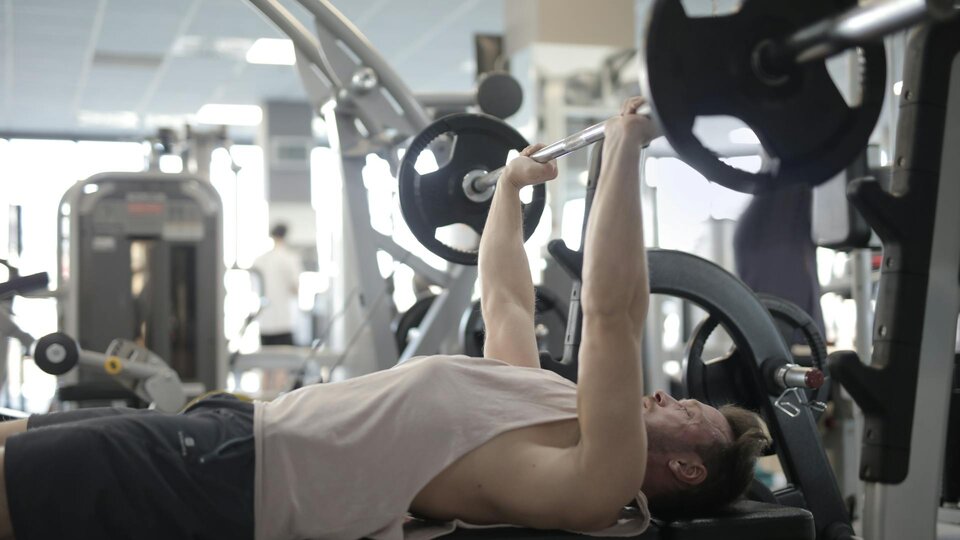In this short article, we will learn the techniques and cues to help you master the bench press. It is critical to understand shoulder stability, which is why we are here to talk about it. The bench press is a horizontal push movement pattern that has its place in any program. This exercise is potent at building postural stability, chest and shoulder strength, and hypertrophy.
From the feet to the eyebrows, there are many insights to employ in one of the most iconic upper body strength exercises for maximal stability, strength, and shoulder longevity.
Set-Up
It all begins with the setup. To begin, align the barbell over your eyebrows. This position ensures a seamless lift-off that isn’t too strenuous and a clear bar path. Next, drive your feet into the floor to create tension throughout your body. This technique aligns with the principle of “Proximal stability for distal mobility” (1). In other words, remove all extraneous movement to create a stable platform for the working muscles to produce strength.
The grip position will depend on which muscles want to be emphasized in the lift and, most importantly, the most comfortable position for the shoulder joints (3). Try different grip widths at a lighter weight to decide what feels most comfortable to the shoulders. Set the bar on the metacarpal over the thumb or the lower half of the hand closest to the wrist.
Lift-Off
Once in a stable setup, the lift-off phase begins. However, don’t start the descent before checking off the bullet points below. Otherwise, instability is risked, which directly decreases strength output and potentially increases injury risk to the shoulder (5):
-
Squeeze the shoulder blades together
-
Use the lats to pull the shoulders down
- Imagine the bench press as just as much of a lat exercise as a chest exercise
-
Pin or settle the bar right into the anchored shoulder blades
-
Create an external rotation force in the shoulders by trying to bend the barbell
With the above “lift-off stability checkpoints” in place, the shoulder complex is now highly stable and ready for action. Ensure that the above techniques remain in place throughout the descent and ascent.
Descent and Ascent
As the bar moves through the complete repetition, it is vital to maintain a mostly straight bar path. With a mostly linear path (a little horizontal deviation is acceptable), energy and stability allow maximal strength output (2,4). Most mistakes can be avoided simply by following the techniques and cues reviewed.
Next, support the wrist in a neutral to slightly extended position. Ensure that the wrist remains over the elbows through the complete repetition. The wrists should track over the elbows without any other movement.
It is important to note that all the techniques during the setup and lift-off remain active. One easily forgotten cue is “bend the bar.” This cue causes the shoulders to rotate externally, which places the elbows slightly inward instead of flaring out to the side.
The reason this is important is because the bench press exercise causes a sizeable internal rotation force in the shoulders due to the pectorals being internal rotators. By creating a counterforce through external rotation, the lifter can maintain maximal shoulder stability for a seamless lift.
Outro
From the initial setup to the controlled lift-off and the subsequent descent and ascent, the importance of stability cannot be overstated.
Notice that most bench press mastery begins before the bar lowers. It occurs during the setup and lift-off techniques that create stability, not the actual movement of the bar. When using stability techniques, lifters will avoid most mistakes; everything else falls into place, and the barbell seamlessly moves. Optimizing stability through the whole movement makes the difference for maximal strength and shoulder longevity.
Now that your understanding of the bench press technique has deepened, bench press confidently!
Sources
-
Kibler WB, Press J, Sciascia A. The role of core stability in athletic function. Sports Med. 2006;36(3):189-98. doi: 10.2165/00007256-200636030-00001. PMID: 16526831.
-
Lawrence MA, Leib DJ, Ostrowski SJ, Carlson LA. Nonlinear Analysis of an Unstable Bench Press Bar Path and Muscle Activation. J Strength Cond Res. 2017 May;31(5):1206-1211. doi: 10.1519/JSC.0000000000001610. PMID: 27548799.
-
Mausehund L, Krosshaug T. Understanding Bench Press Biomechanics-Training Expertise and Sex Affect Lifting Technique and Net Joint Moments. J Strength Cond Res. 2023 Jan 1;37(1):9-17. doi: 10.1519/JSC.0000000000004191. Epub 2021 Dec 23. PMID: 35157403.
-
Mausehund L, Werkhausen A, Bartsch J, Krosshaug T. Understanding Bench Press Biomechanics-The Necessity of Measuring Lateral Barbell Forces. J Strength Cond Res. 2022 Oct 1;36(10):2685-2695. doi: 10.1519/JSC.0000000000003948. Epub 2021 Feb 4. PMID: 33555823.
-
Stastny P, Gołaś A, Blazek D, Maszczyk A, Wilk M, Pietraszewski P, Petr M, Uhlir P, Zając A. A systematic review of surface electromyography analyses of the bench press movement task. PLoS One. 2017 Feb 7;12(2):e0171632. doi: 10.1371/journal.pone.0171632. PMID: 28170449; PMCID: PMC5295722.
